During the construction of small country or country houses, most homeowners solve the problem of sewerage drainage simply - they dig a cesspool, where all the waste of the residents is drained through pipes. But the time “H” comes and the accumulated sewage reminds of itself with a pungent smell. So, it's time to get down to not very pleasant work - pumping out the contents and exporting them. And how to clean a cesspool without pumping? The current achievements of technologists make it possible to do this without spending money on attracting professionals.
Unlike a septic cesspool is a primitive storage without any signs of sewage treatment. And all its contents are stored there in full until the moment of pumping out. And not just stored: an "explosive" mixture of feces, food waste and detergents is a potential threat to human health if it enters the soil. Therefore, timely cleaning of toilets and cesspools is so important: their overflow leads to environmental contamination.
In addition, a drain pit filled to the brim emits a very unpleasant odor that can negate the delights of living in nature.
Tip: To avoid force majeure, you should take care of cleaning the cesspool in the country when it is two-thirds full.
Cleaning methods
cleaning drain pit can be done in three ways:
- pumping out the contents with its subsequent export;
- treatment with special chemicals;
- with the help of bacteria.
And you know that there may be details in a separate article.
A relatively inexpensive alternative to a cesspool can be. A wide range of models will allow you to choose the right wastewater purifier.
Pumping method

This method belongs to the category of traditional ones and is the first to be remembered when answering the question of how to clean a cesspool in a private house. The operation can be entrusted to an organization that has sewage equipment. The machine, equipped with a pump and a container for collecting sewage, quickly copes with the task. And for an additional fee, you can also order washing the internal surfaces of the drain pit.
However, pumping out cesspools justifies itself only if the shoveling pit has a solid volume, and the owner has taken care of organizing an access road to it. It is economically unjustified to clean small collections of sewage (for example, in a country house) using expensive equipment. Here, the owner may well cope with the work himself, armed with the necessary equipment for pumping out cesspools:
- a container for collecting the pumped out substance.
Important: Do-it-yourself work on cleaning the cesspool should be carried out in special clothing and with respiratory protection (respirator or gas mask). Clothing should be rubberized, shoes - rubber, hands should be protected by durable waterproof gloves.
The pump for pumping out cesspools is selected according to performance depending on the volume of the cesspool. It is better to buy a plastic container with thick walls, equipped with a neck for pumping liquid and a lower drain hole for emptying it.
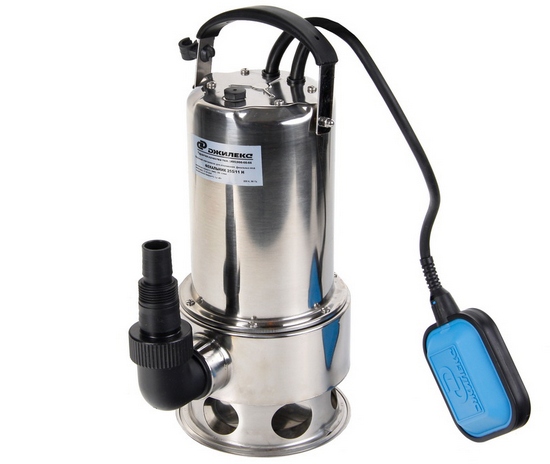
Biological method
The one who faced mechanical cleaning toilet or cesspool, knows that this is an unpleasant business. It is not surprising that the owners of private houses are interested in the question of how to clean cesspools without pumping.
You can declare "biological warfare" to sewage. It is carried out with the help of special bacteria that can decompose organic compounds. As a result of their work, the contents of the pit turn into a substance that is harmless to human health and life. The volume of fecal matter is reduced by at least half. They turn into a cloudy liquid, devoid of an unpleasant odor. After this treatment, it can be used for watering beds.
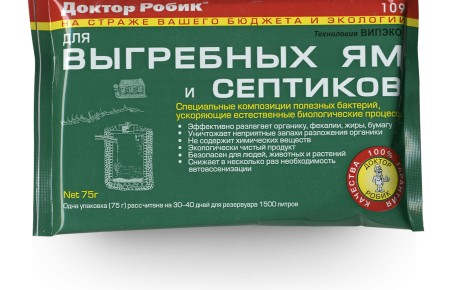 Another way to remove the smell from the cesspool and clean it is to use the Dr. Robik biopreparation.
Another way to remove the smell from the cesspool and clean it is to use the Dr. Robik biopreparation. Before you clean the drain pit without pumping out, you need to know that biological products used to clean cesspools and septic tanks do not tolerate household chemicals. If chemical detergents, washing powders are used in the house, biological wastewater treatment will have to be abandoned.
Chemical cleaning
Chemicals for cleaning cesspools and toilets have been used for a long time. The most accessible of these has always been formaldehyde. However, recently it has practically disappeared from free sale due to its carcinogenicity and high toxicity. In addition to formaldehyde, wastewater treatment uses:
- nitrate oxidizing agents: they contain surfactants in their composition, which are able to break down organic matter. They are not afraid of detergents falling into drain pits;
- ammonium compounds (quaternary): do an excellent job, but from the point of view of environmental impact, they are completely unexplored. In addition, these drugs do not work well in effluents containing household chemicals;
- bleaching powder: as well as formaldehyde, it is rarely used at the present time due to its harmful effect on a living organism.
If you use ammonium to clean the cesspool, do not pour the resulting liquid onto the soil. It is better to call specialists with a sewage machine: they will pump it out and take it to the proper place.

Fighting odors
One of the most unpleasant aspects of local sewage is its ability to spread a specific smell around. Pumping out feces does not save him either: after visiting the site of the sewage machine, the “aroma” can last for several days.
How to remove the smell from the cesspool? With the help of the same biopreparations. They are supplied to retail chains in the form of powder, liquid or tablets.
Liquid formulations have a high concentration, which has a very significant impact on the homeowner's wallet: a small amount of concentrate can handle a fairly large amount of waste.
Powders, unlike liquid products, require prior "revitalization". They require water to activate. Diluted according to the manufacturer's instructions, the powder is ready to fight sewer odors.
Summer residents liked the most medicines in the form of tablets. It is convenient to use them - the tablet does not need to be dissolved in water. It is enough to throw it into the cesspool.
What is and how they work, we told in a separate article.
About the features of the organization of drain pits in a private house. Choice of materials of manufacture and place for construction.
At the stage of building a bath, it is important to properly drain the water from it. About this is ours.
When choosing a method for how to clean and how to remove the smell from a cesspool, the following points should be considered:
- the use of chemicals harms the metal components of the local sewer system;
- the presence of a dishwasher and washing machine in the house involves the use of detergents that make it useless to use bacteria that clean drains. They will quickly die from contact with household chemicals. As a result, you will spend money and not clean the drain hole.
From this point of view, the most universal is still mechanical way removal of sewage, but the use of special preparations will significantly reduce the number of calls for sewers.
Speaking about how much it costs to pump out septic tanks and cesspools, the price here can be in the range of 700-900 rubles per 1 cubic meter and also depends on the volume of the required machine.
How to pump out a cesspool with a pump is shown in the video.
Silt is sediment at the bottom of a pit. His appearance is normal.
Sooner or later it has to be formed. Another thing is that during the construction of the pit, you (or someone) could contribute to its early appearance by making mistakes in the design.
All walls and bottom of the septic tank had to be airtight.
If the bottom was left "as is", then this is already a well. In this case, quicksand, soaked clay, etc. are added to the wastewater.
Now it's too late to blame anyone. Let's better figure it out together: what to do if the cesspool is silted up?
How to find out that this trouble happened to the pit?
Here are some signs:

- The hole began to fill faster than before. More often you have to pump out;
- The stench comes from the pit;
- Fat deposits are visible on the walls;
- At the bottom is a layer of silt.
Cleaning methods
We conditionally divide the methods of dealing with silt into independent and with the involvement of technology. Let's make a reservation right away that attracting equipment, although it costs money, is much easier and more efficient. However, there are places where it is not so easy to call the cesspools, so there are always "old-fashioned" methods.
Goldsmith Method
For pumping out, you can not spare the water pump (although it is not intended for this). Then install a mesh with 1-2 mm cells on the receiving funnel.
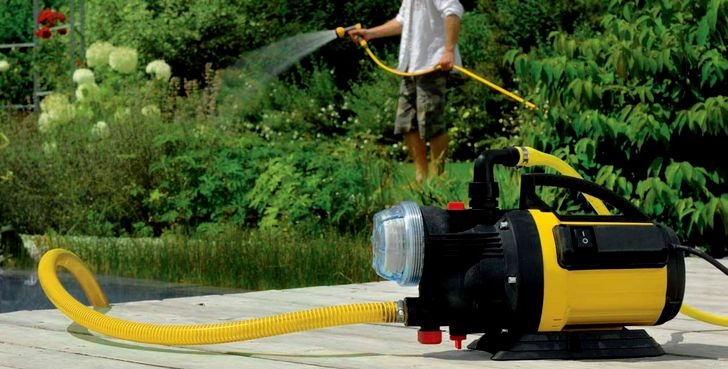
Water pump
The liquid is discharged into a hole previously dug nearby (where the liquid will be absorbed rather quickly and it can be immediately buried). Or in a container that can be taken out.
After the liquid is removed, what is not pumped out by the pump is removed from the bottom with the help of a brave worker manually using a bucket and a rope.
Semi-automatic for a small hole
If the car is available for you, and the pit is small (for example, from tires), then you can make a pole with a hat and try to thoroughly mix the dense, caked silt with the liquid.Making a hat is up to you, it can resemble an oar, or a disk attached perpendicularly, the main thing is to keep it well.
After everything is mixed, we call the sewer machine. She can suck out the liquefied sludge.
 In the absence of a centralized sewage system, the only way out is the construction cesspool. is the simplest and most reliable choice. Step-by-step instruction to create a drain pit - read on our website.
In the absence of a centralized sewage system, the only way out is the construction cesspool. is the simplest and most reliable choice. Step-by-step instruction to create a drain pit - read on our website.
Read about the device of a toilet bowl for a country toilet. Choosing a place for a toilet cubicle and installing a toilet bowl.
And here you will learn how to choose a dry closet for a summer residence. Overview of models, device and principle of operation, as well as reviews of dry closets.
Waste tank - water - sewer
If the hole is too deep, or you don't feel like fiddling with the pole, you can get rid of the silt by calling a special. technique twice. The first time she pumps out the slurry. Then we find a way to fill the hole clean water(with the same sewer, fire engine, or its powerful pump).

Pumping out sludge from the drain with a cesspool
Under the pressure of water, the silt from the bottom is stirred, becomes loose, and now, when it is re-cleaned with a sewer, it will be completely removed.
It is clear that the re-call of the machine is needed only if the silt at the bottom is dense and caked. But often the vacuum cleaners are powerful enough to cope with the task the first time.
bacteria
Now they produce special biological products for cleaning cesspools. Microorganisms clean the walls of septic tanks, pipes, soften sludge, “digest” waste, leaving behind water, mineral sediment and carbon dioxide.
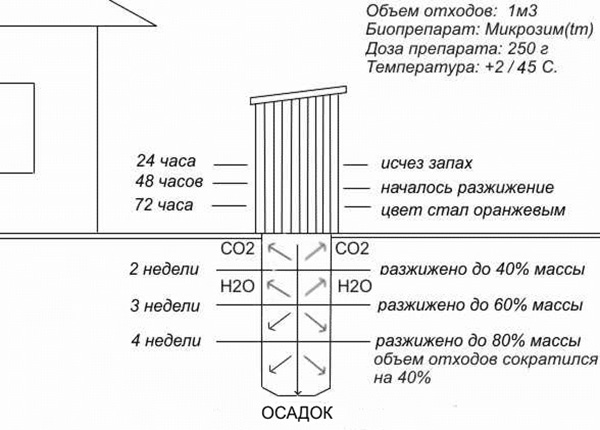
Cleaning a septic tank with a biological product "Mikrozim"
The advantages of the method are that:
- Easy to implement;
- Does not harm the environment;
- Eliminates unpleasant odors.
On the package you will find instructions on what and how to do.
If the hatch on your pit closes tightly, be careful when buying: if it is written that the bacteria are aerobic, then they need fresh air. In a sealed septic tank, they will quickly die.
Bacteria also have disadvantages. Like any living creature, they are whimsical:
- They dislike bleach, powders, and detergents;
- If t is below 0 o C, or above +40 o C - organisms die;
- They also die from "old age" - you need to periodically replenish the colony.
chemicals
 In winter, chemicals can be used. The safest among them are nitrate oxidizers.
In winter, chemicals can be used. The safest among them are nitrate oxidizers.
If you use nitrate fertilizers in the garden, then this reagent will not cause you concern.
The tool will liquefy the sludge, just keep in mind that it should not be frozen.
Waste of household chemicals for the reagent is not terrible, but its cost for someone can be tangible.
In the past, chemicals such as ammonium salts and formaldehyde were used. But they are toxic and bad for the environment.
This unit will solve all your problems with the pit. It has more power than a conventional vacuum cleaner, the depth of which it can handle is 16 m. (In contrast to the 6 m. of a vacuum truck).
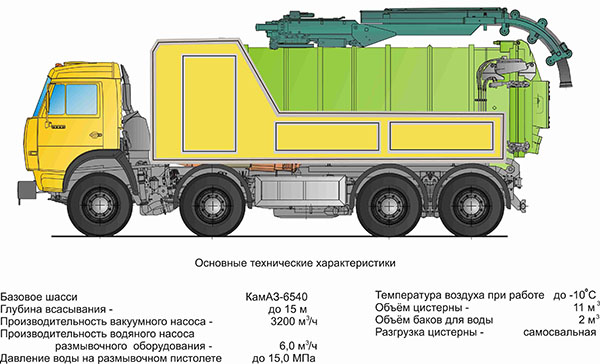
Heavy Duty Suction Machine
Some silt pumps have nozzles that allow you to supply water with high pressure to cope with dense silt.
Next steps
Now that the sludge has been pumped out, it all depends on how your pit is set up. If it is airtight (the bottom is concrete, for example), then the work is over - you can continue to safely use the toilet.
If you left the bottom earthen, or covered it with rubble, you need to make sure that in the near future the pit is not covered with clay again.
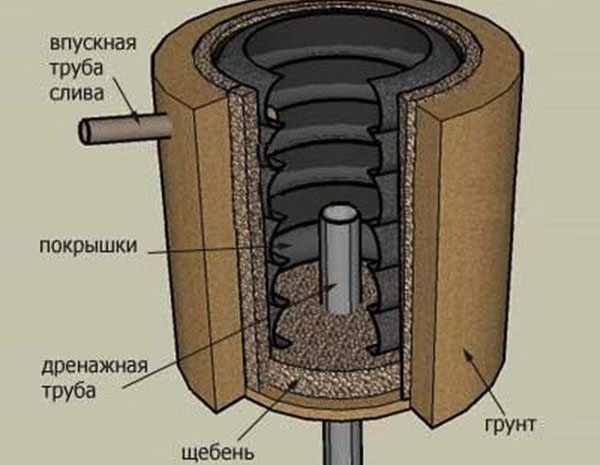
Sandy soils absorb moisture well. After cleaning, you can update the gravel layer and enjoy. But to tell the truth, this is not a very good solution. The gravel will quickly become covered with silt again, and all procedures will have to be repeated..
Still, it would be better to spare no effort and money and pour concrete base(this is especially true for cesspools in loamy soils). This will help to significantly push back the time of the next serious sewer cleaning!
 Wastewater treatment plant are simply necessary for waste disposal in a private house. - polymer tank, septic tank, cesspool. System care.
Wastewater treatment plant are simply necessary for waste disposal in a private house. - polymer tank, septic tank, cesspool. System care.
You might be interested in learning about ways to clear clogged sinks. Read about how to clean pipes with a plunger, plumbing cable and chemicals.
Related video
Classmates
Where to put waste if there is no centralized one? The most popular way is to arrange a cesspool on the site. country house. There are several types of sewer systems, each of which differs in installation and operation features.
Silting is a common problem owners face. sewer pit. It happens inevitably. During operation, not only watery waste, but also fecal matter, solid sewage enter the sewer. They become the reason why the cesspool silted up.
If formed in sewer tank silt, the functionality of the system is sharply reduced. She can no longer effectively cope with the waste entering her. As a result, the accumulation of liquid waste at the bottom, the overflow of the sewer pit with water. The situation is aggravated if the walls are also covered with fatty deposits. Then liquid waste simply cannot go into the ground due to the lack of a passage.
Silting and overflow of the cesspool
The cesspool needs to be provided with quality service so that problems such as silting do not arise. It is good if the owner of the house notices in time that there are some problems with the sewer system. If you start the state, you will have to decide not only how to get rid of the silt in the cesspool, but also how to improve the sanitary and hygienic condition of the territory, because sewage can pour out, forming a persistent, unpleasant smell in the area that enters the house.
How to remove sludge from a cesspool
The sludge in the cesspool is a thick layer of sediment that microorganisms living in the ground cannot cope with. The accumulation of sludge occurs regardless of what type of sewer system is installed on your site. Timely resolution of the problem will help prevent unpleasant consequences. Here the owner has the right to decide for himself whether to turn to a sewage company for help or do everything himself.

Professional cleaning of the cesspool with sewage equipment
Today, silting a cesspool is not an impossible task. There are a number of ways to correct the situation:
- professional cleaning with cesspool equipment;
- removal of the sludge layer with a fecal or water pump;
- use of biological products or chemicals.
It is not necessary to allow liquid waste to rise high due to silting of the sewer pit. You need to solve the problem after the first signs appear. Pouring sewer waste outside is not only an aesthetic problem. Bacteria live in sewage, which are carriers and pathogens of infections.
Help from the vacuum cleaners
Each owner over time is faced with the fact that the cesspool has silted up. What to do in this case, how to correct the situation and prevent the appearance of an unpleasant odor? How to restore the performance of the sewer system?
The easiest way is to call the sewage company and order the services of professionals. So you can save your nerves and efforts and save yourself from such an unpleasant job. But be prepared for the fact that the services of vacuum cleaners are not cheap. The price includes not only cleaning the pit from the silt layer, but also the disposal of sewage.
Before calling the experts, make sure that your site has access for equipment. The depth of the cesspool should not be more than three meters, since the hose of the sewer machine is designed for just this size.
Instead of using a traditional waste hose, professional workers can use a device called an ilosos. This is a special device with a hose up to 16 meters long, which is used to destroy a layer of dense sludge. As a result, the functionality of the sewer system is restored, problems with the accumulation of liquid waste or the occurrence of a fetid odor on the site go away. Calling vacuum trucks is the best, but not the most profitable solution for how to remove sludge from a cesspool.
DIY cleaning
To save on the services of professionals, you can try to eliminate the silting of the cesspool yourself. What to do, where to start?

Do-it-yourself cesspit cleaning
First you need to decide which method you prefer to use to get the job done.
- Pump. You will need a fecal or water pump and several nozzles for it. You need to download everything you can. The silt itself is destroyed and removed with a bucket and a rope.
- bacteria. In this case, you also cannot do without a pump, but the procedure is simpler. We also pump out the waste, fill the container with water, pour in the biological product. Microorganisms will corrode the layer of silt, and the water will easily go into the ground.
- Chemicals. They work in the same way as biological ones. They are more aggressive, so precautions should be taken.
Note! If you use a water pump to pump out sewage from a sewer pit, do not forget to stock up on nozzles. They will need to be changed very often to prevent failure of the device.
If the cesspool is silted up, what to do will be the main issue that requires an immediate, effective solution. Timely pits are the key to its high-quality functioning. Spare no time, effort or money, because if the waste spills out, it will be a problem on a different scale.
- Complete water change
Artificial ponds are a great decoration option personal plot. They themselves are quite decorative, in addition, the plants planted around them create an atmosphere of sophistication and comfort. But, as you know, even the smallest reservoir soon begins to overgrow and become polluted, and in order to put it in order, the owners face the question of how to clean the pond.
Water replacement and cleaning of the reservoir should be done every 3 years.
If we talk about large areas of water, then usually in order to clean them of silt, special machines called dredges are used. The use of such devices on the territory of a suburban area is impractical, therefore, do-it-yourself cleaning options should be considered.
How to clean garden ponds yourself
To date, there are 4 main methods of do-it-yourself cleaning - chemical, biological, mechanical and ultraviolet radiation.
Basically, all of them are based on the use of special devices and instruments, which are currently developed by many both domestic and foreign manufacturers.

During cleaning, remove deposits on the bottom and cut off dead parts of the vegetation.
The simplest and enough effective method, which can small size, putting his hands to this, - the use of a special net. With the help of this tool, the surface of the water is cleaned of small debris and leaves. But it is almost impossible to remove the silt formed at the bottom with a net.
In this case, the use of cleaning containers equipped with a filter element is justified. Gravel, quartz sand or granules of a special composition are used in containers as filters that are directly used for cleaning. As soon as water stops flowing out of the filter, the device should be removed and the filter element replaced. Water from ponds is pumped into containers by special pumps, the power of which depends on the size and depth of the pond.
Also, cleaning can be done using a special underwater vacuum cleaner, which, in turn, can be manual or automatic. A hand-held vacuum cleaner, mounted on a telescopic tube, descends into a pond, moves along the bottom with its own hands and sucks up water along with dirt, silt and debris. The filtered water flows back into the pond, and all pollutants remain on the filter screen. With the help of such a vacuum cleaner, you can easily and quickly clean a pond with a diameter of up to 10 m. Cleaning with an automatic vacuum cleaner occurs in a similar way, only the vacuum cleaner moves along the bottom on its own.
Back to index
Chemical and biological cleaning methods
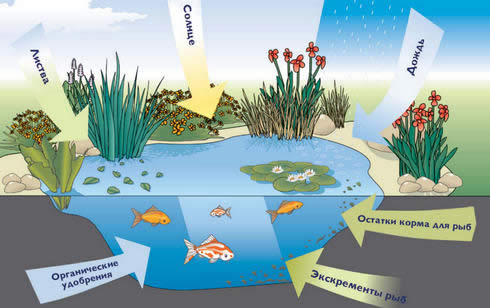
In addition, do-it-yourself cleaning can be done biologically. Such purification is based on the decomposition of substances. All silt and dirt under the influence of special bacteria turns into methane, hydrogen sulfide and carbon dioxide. Often the biological method is used in conjunction with the mechanical one.
Cleaning with bacteria is carried out as follows. A porous substance is located in the filter chamber, which promotes the development of microorganisms that feed on organic substances. When water passes through the filter, the dirt settles on it, the bacteria process the dirt into organic matter, and the purified water is returned back to the reservoir. Cleaning with biological installations is usually carried out in ponds up to 0.5 ha.
If it is impossible to use for cleaning various mechanisms and devices, it is possible by a chemical method. In this case, chemical reagents are added to the reservoir, the task of which is to normalize the level of acidity, increase the oxygen content and dissolve the algae. Usage chemical method it is undesirable if fish live in the pond, and the reservoir itself is used for swimming or water intake.
The last way to purify water with your own hands is to use devices with ultraviolet radiation. Such devices, as a rule, consist of a housing in which an ultraviolet lamp is located, and a mechanism that prevents the device from becoming overgrown with algae and silt. For effective operation in the device, it is necessary to replace the lamp after 1-2 years.
Usually a cesspool requires very careful maintenance. It must be pumped out frequently, as well as the use of products that prevent unpleasant odors and rapid filling. Therefore, a cesspool is not the best option containers for autonomous sewerage. In this capacity, it is often recommended to use septic tanks, because they are more practical. Cesspools are more suitable for country toilets. In such cases, so-called open cesspools are built. They usually do not have a bottom, or there are several holes in the body. Due to such features, the liquid part of the waste is absorbed into the soil. The pit is gradually self-cleaning, and it is less necessary to resort to various pumping methods. True, in this situation another problem arises - how to get rid of silt in a cesspool?
Silt is a sediment at the bottom of reservoirs and cesspools, consisting of organic debris and minerals. It is formed as a result of the action of bacteria that feed on various organic compounds. As a result of their work, all garbage is processed and divided into two layers. Water remains on top of the tank, which is absorbed into the ground, and below is a silt sediment.
Getting rid of it is the main problem with using pit latrines, even for toilets. The sediment does not go anywhere, but gradually accumulates at the bottom. Sooner or later you have to get rid of it.
The simplest of the available methods is pumping out sludge using special equipment. Most often, for this they resort to the services of a sewer machine. It consists of a waste collection tank, pumping equipment and a durable hose. The latter is placed in a pit and transfers all the waste from the pit to a container that is installed on the chassis of a large car. You do not need to participate in the pumping. All the work is done for you by an experienced specialist.
When cleaning the pit latrines of outdoor toilets, there are often problems associated with the viscosity of the sludge. In this case, it will simply not be possible to pump out the pit completely, and you will lose time and money, because you still have to pay for the services of the machine.
Therefore, many recommend that before carrying out a complete cleaning, prepare the pit in advance in an appropriate way.

For this, biological preparations are used. They contain live bacteria that accelerate the natural processes of waste decomposition. As a result, the sediment becomes more liquid, and it is already very easy to pump out the pit.
You can buy bacteria for septic tanks and cesspools at any hardware store. It is best to purchase the product in the form of granules. Before use, it is enough to dissolve it in water and leave for 15-20 minutes. Bacteria are activated and will be ready to perform their functions.
It is also worth noting that in addition to facilitating pumping, you will receive additional beneficial features:
• An unpleasant smell will go away.
• The population of harmful bacteria will be reduced.
• The time until the next cleaning will be reduced.
• The amount of waste in the pit will be reduced.
Here's to you simple instruction how to get rid of silt in a cesspool. It is enough to first prepare it with the help of biological preparations, and then pump out the waste mechanically.
